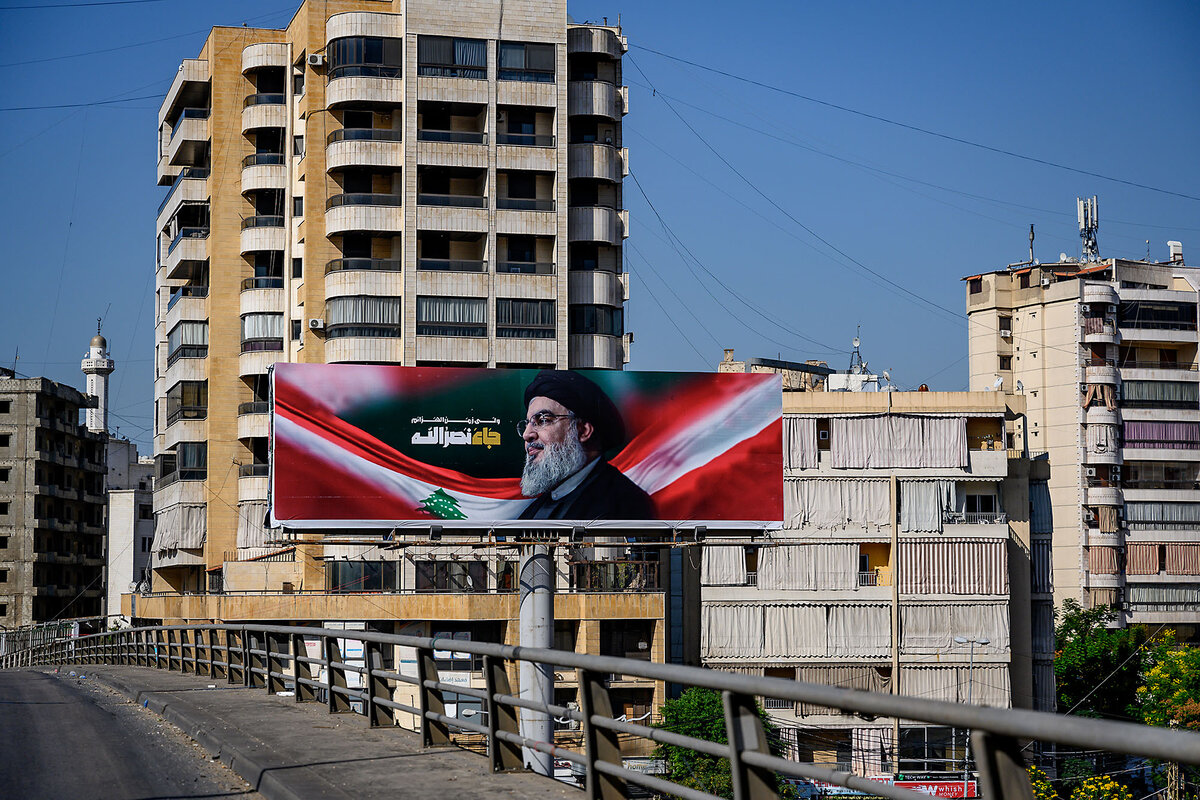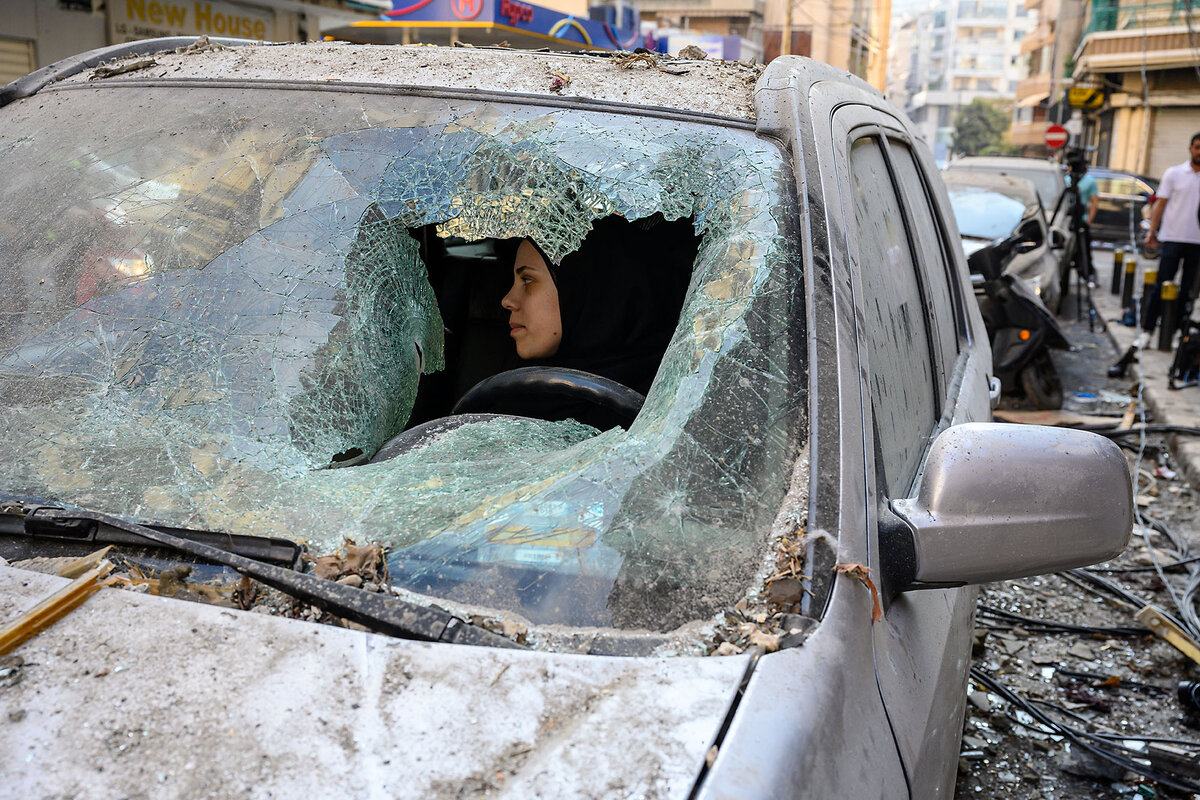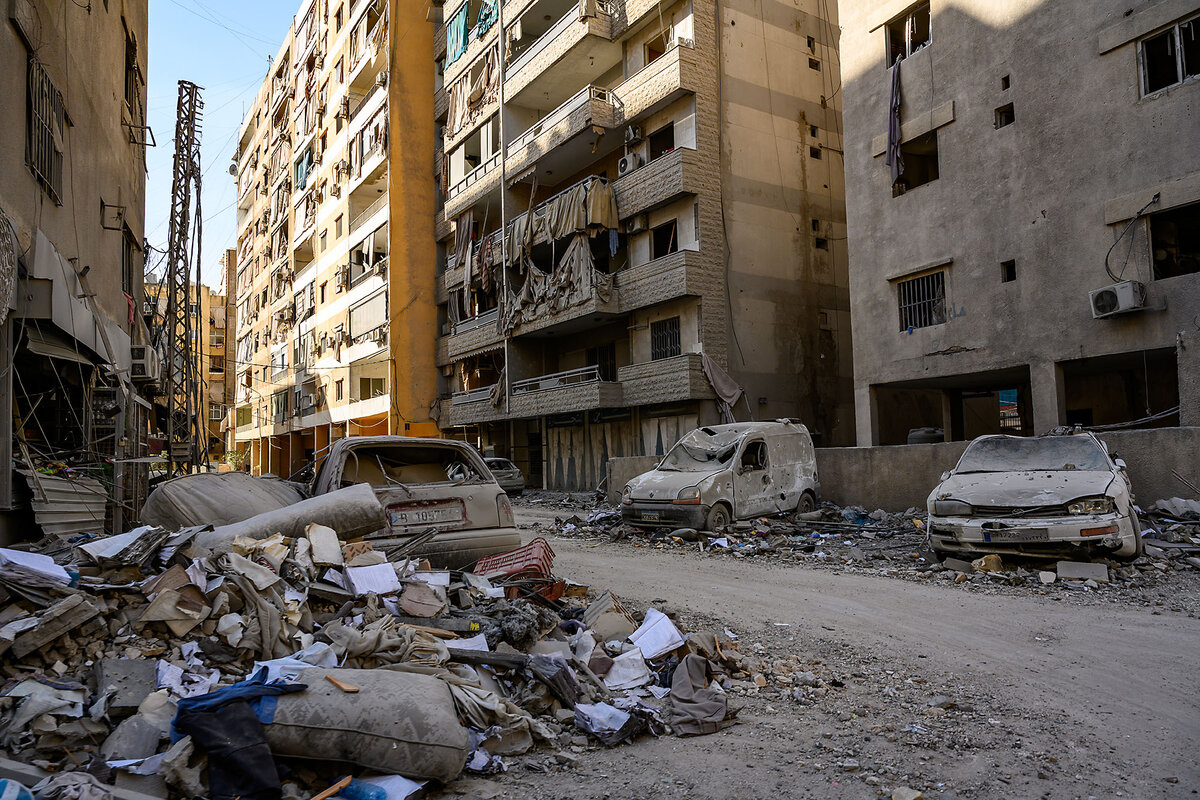Where Hezbollah stands, and what’s at stake, after battering by Israel
Loading...
| BEIRUT
The Israeli airstrikes on a crowded central Beirut district after nightfall Thursday came without warning, in an apparent attempt by Israel to add to its long list of top Hezbollah leaders and commanders assassinated in recent weeks.
The airstrikes brought down one entire apartment block – within it, a long-standing Hezbollah office – and damaged another, leaving 22 people dead and the local Shiite community in shock.
“I am surprised by what happened – there is nobody here, just families, and I know them all,” says one man who gave the name Haidar, as he breathed the acrid burnt air that permeated the district Friday and cleared rubble from the crumpled roof of his car.
Why We Wrote This
A story focused onIsrael’s assault on Hezbollah in Lebanon represents a dramatic broadening of the yearlong war in the Middle East. How Iran’s most important regional ally responds will determine the postwar balance of power between Israel and Iran.
Hezbollah said Israel’s apparent target, senior official Wafiq Safa, was not among the casualties.
If so, it was a rare miss for Israel, which has demonstrated that its intelligence has thoroughly penetrated the Iran-backed Shiite militia and knocked the once-impervious organization off balance with a steeply escalating string of attacks.
Those blows stretch from thousands of exploding Hezbollah pagers and walkie-talkies to killing the group’s iconic leader of three decades, Hassan Nasrallah, and launching a so-far limited ground incursion into southern Lebanon. Its air campaign against Hezbollah started with 1,300 airstrikes in a single day.
How Hezbollah is able to respond on the battlefield, amid the most serious setbacks since its founding 42 years ago, could determine the postwar shape of the Middle East.
Hezbollah’s status
At stake for Hezbollah is its reputation as the most powerful arm of the Iran-led “Axis of Resistance”; its ability to continue leading the fight against Israeli and American influence in the region; and its stated role at home as the armed “defender” of Lebanese sovereignty.
Israel’s Prime Minister Benjamin Netanyahu this week boasted that Israel had cut deeply into Hezbollah’s leadership ranks, saying it had eliminated not only the presumed successor of Mr. Nasrallah, but also “the successor to the successor.”
Israel’s stated war aims are to remove the threat of Hezbollah from its northern border, so that 65,000 displaced Israeli residents can safely return home. Yet Mr. Netanyahu also offered the Lebanese people a stark choice in a video message this week: Reject Hezbollah, he intoned, “to save Lebanon before it falls into the abyss of a long war that will lead to destruction and suffering like we see in Gaza.”
One possible Israeli gain this week may be Hezbollah’s indication that it would consider a cease-fire, without conditioning it on a cease-fire in Gaza, where its Palestinian ally Hamas has been fighting Israel for a year. Much of the Gaza Strip lies in ruin, and more than 41,000 people, civilians and combatants, have been killed.
In the meantime, Hezbollah says it has already stalled Israel’s advance into Lebanese territory, with hand-to-hand combat on its home turf. Still, the Israel Defense Forces published assessments Tuesday it had killed 450 Hezbollah fighters in the previous week of clashes and airstrikes.
Despite a partial disabling of its communications network, Hezbollah has also stepped up coordinated rocket attacks across northern Israel, including one 30-minute volley Tuesday of more than 100 rockets on the northern port city of Haifa.
“On the ground, all Hezbollah can really do now is to hold on, deny Netanyahu his immediate war goals, keep firing those rockets, and let the international community come up with some kind of solution down the road,” says Nicholas Blanford, a Beirut-based expert on Hezbollah and a senior fellow of the Atlantic Council think tank in Washington.
Hezbollah’s remaining arsenal
Israeli troops are trying to dismantle Hezbollah infrastructure along four parts of the border. But wary of lessons from 2006, when Israel and Hezbollah last fought an all-out war for 34 days, Israeli forces are being “ultracautious,” he says, and so far only advancing a few hundred yards into Lebanon.
Still in Hezbollah’s arsenal are an unknown number of precision-guided missiles, which can reach any point in Israel but have not yet been substantially deployed. Hezbollah in mid-August reminded Israel of this purported capability in a video of an underground tunnel network. Trucks loaded with missiles, and uniformed Hezbollah operatives on motorcycles, were shown driving through the tunnels.
Israel says it has destroyed half of Hezbollah’s precision-guided missile arsenal during its air campaign. Some suggest that only Hezbollah’s Iranian sponsors can order their use, since those missiles are widely billed as Iran’s first line of defense against an Israeli attack on Iran.
But there may be other reasons Hezbollah has not yet played this card, says Mr. Blanford, author of “Warriors of God: Inside Hezbollah’s Thirty-Year Struggle Against Israel.”
“Right now, Hezbollah doesn’t need to use them. It’s achieving its effects – denying Israel’s 60,000-plus civilians from going back to their homes – by using older systems,” he says.
“At the moment, this is not a full-scale war. It may look like it, but it is not, because infrastructure on both sides is not being deliberately targeted,” says Mr. Blanford, noting that in 2006 the Israelis swiftly knocked out the Beirut airport, port, and bridges.
“Hezbollah said this is going to be a long war, so they are not going to shoot off everything at the get-go,” he says. “I think they are holding it in reserve for the day that it escalates to infrastructure.”
After blows, talk of a cease-fire
Israel may have missed its Beirut target Thursday night. But proof of Israeli intelligence prowess is obvious in the southern suburb of Dahiya, close to the Beirut airport, where Israel last week delivered multiple blows with bunker-buster bombs, over several days, to kill Hashem Safieddine – the man widely tipped to replace Mr. Nasrallah.
A deep crater still seeping smoke is all that remains of Mr. Safieddine’s apparent underground bunker. Addressing fighters this week, Hezbollah’s deputy leader Naim Qassem, a cleric and not a commander, took on a confident and defiant tone, and vowed that “many more residents” of northern Israel “will be forced to flee.”
But he also said Hezbollah would entertain a cease-fire, for the first time not making it conditional on an Israeli cease-fire with Hamas in Gaza.
Such a move comes amid Mr. Netanyahu’s threats to Lebanese to either oust Hezbollah and risk a civil conflict, or risk an outcome like Gaza, “neither of which is tenable,” says Maha Yahya, director of the Carnegie Middle East Center in Beirut.
“What we’re looking at is an escalation on steroids,” she said in a Carnegie media call Wednesday. “I have a lot of concerns that we’re seeing a Gaza 2.0 in Lebanon. A lot of the actions that are being adopted by the Israelis in Lebanon mirror what has already been happening in Gaza, and the goalposts of Bibi Netanyahu are changing constantly.”
Already Lebanese officials say that the national death toll since Sept. 23 has climbed above 2,100. Much will depend on how the Hezbollah-Israel fight unfolds.
“There was a lot of hype around the state of the organization, that they are completely paralyzed and unable to put up a fight against the Israelis,” says Mohanad Hage Ali, deputy director for research at the Carnegie Middle East Center.
Hezbollah went into “autopilot” after the high-profile assassinations and pager attacks, but now appears to have regained some of its footing, with the Haifa barrage “an escalatory turn, in terms of intensity and consistency,” he said in the Carnegie call.
“This is a race between how fast Israel can grab that territory it intends to take in the next phase, whether it be a week or two weeks,” says Mr. Ali. “Or would Hezbollah be, like in 2006, able to slow it down for 30 days? If that’s the case, it’s going to be difficult for Israel – time will not be to Israel’s advantage.”









